Indistylemen
Shoe Toe Shapes and Detailing Explained
- Get link
- X
- Other Apps
The toe of a shoe is the most forward projection of your body, so it literally leads the way for the rest of you. Therefore, it’s an important style consideration that will most likely be the design focus of your shoe purchases.
The shape and decoration of the toe of your shoes will almost certainly be noticed first. In this article, we’ll explore the various shapes and ornamentation possible on a shoe’s toe and how it can affect appearance and comfort.
The Shape of a Shoe Begins with the Last
The overall shape of a shoe is created by the last, which is the name for the form traditionally made of wood and hand-carved by the shoemaker. These days lasts are also machine-made or 3D-printed from plastic.
The last then serves as the mold for the upper of the shoe, thus giving it shape. The leather is stretched on the form and allowed to sit there for some time (often several weeks) until the shoe upper holds its desired shape. Shoemakers will name or number their lasts to distinguish them for themselves and their customers. The shape of the last determines the fit and shape of the shoe as a whole, and these are most influenced by the shape of the toe.
Classic Shoe Toe Shapes
Although there are numerous subtle variations in toe shape, these can be boiled down to a handful of basic shapes, namely round, almond, square, and pointed.
Round Toes
The most basic and traditional shoe shape is the rounded toe. This can be quite spacious and therefore very comfortable, especially if you have broad or wide feet. Because the shape is simple, it tends to be innocuous on most shoes–nothing offensive but perhaps nothing exciting either.
Despite being basic, a truly round toe tends to look best on more structured and heavier shoes, from boots to chunky country derbies (Tricker’s, Church’s, Grenson) to trainers or sneakers, but on loafers, which already are smaller and closer fitting than other kinds of shoe, a round toe can make your feet appear shorter.
This is because the half-circle shape of the toe does not elongate the foot visually but gives it a snubbed appearance. To compensate for this the added mass or bulk of a heavier shoe is necessary. You can see this on the variant of a round-toe shoe called the Budapester, named for its origins in the Hungarian shoemaking tradition. True Budapesters have a spacious toe box with some height to it. You can see the real deal at Vass Shoes from Hungary, but versions of it can be found at Crockett & Jones and elsewhere.
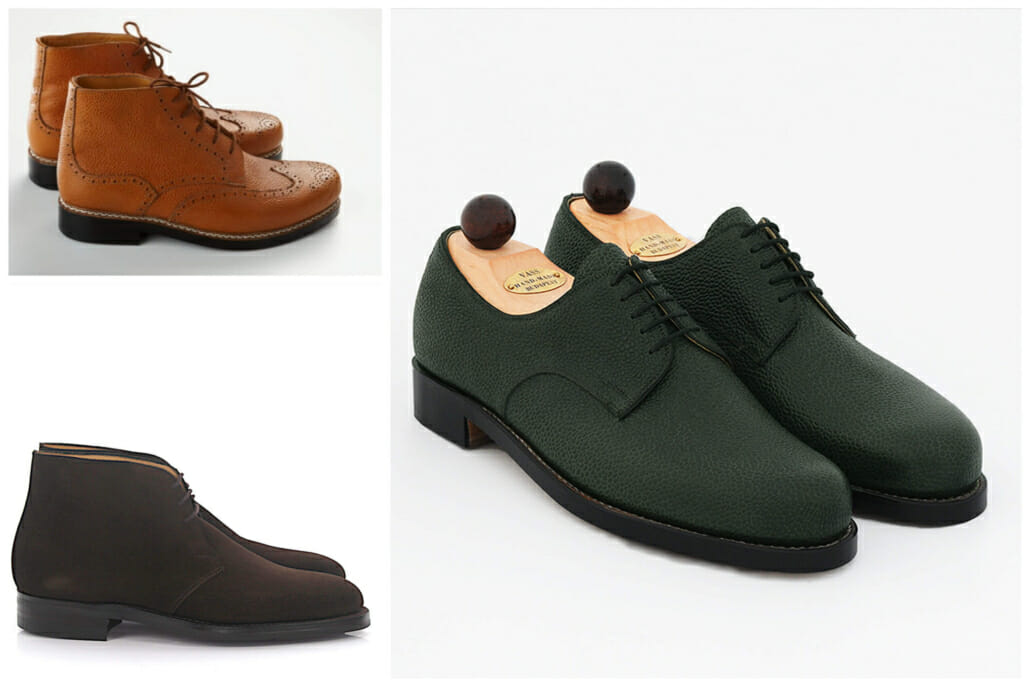
The shortness of a round toe looks best on boots and chunky shoes like these three budapesters because their mass counterbalances the shortness of the toe.
Shoes that you might consider oval at the toe also fall under the “round” umbrella in many cases. These are found on traditional British dress shoes, particularly oxfords. The shape is classic and not showy.
Almond Toes
An almond toe is essentially a more elongated version of a round toe, shaped like the narrower end of the nut it is named after. You can think of it as a tapered oval. In my view, the almond is more flattering and elegant than the simple round toe. It’s also more contemporary with an edge of dandy style. You might say that an almond toe exists in the “Goldilocks Zone” of footwear: among toe shapes, it’s just right. It provides a bit of foot elongation but is not at all extreme. In some more exaggerated versions, you can really identify the almond shape by the way the shoe widens considerably at the ball of the foot (the base of the toes).
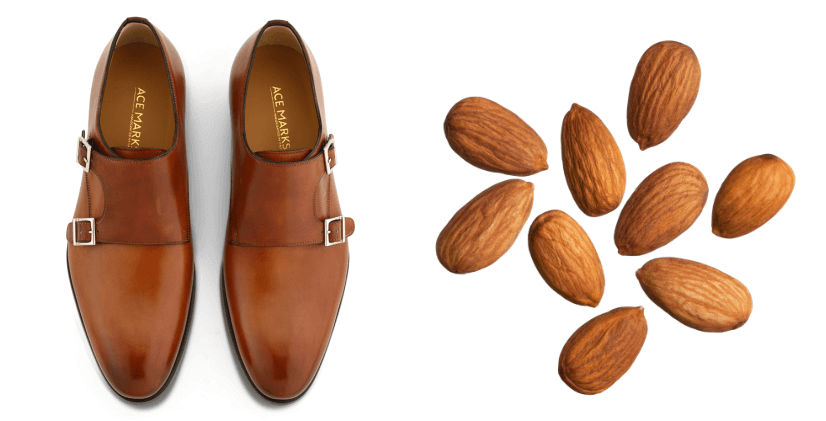
Almond-toe shoes, like these monk straps from Ace Marks have an elegant shape
Some almond-shaped toes can be chiseled. This means that instead of having a smooth curved edge along the outside of the toe, you have straight cuts or angled sides. This is most apparent if you direct your eyes to the sides or bottom of the sole since the softness of the upper can make it less obvious. A good example of the chiseled almond toe comes from British bespoke shoemaker Gaziano & Girling who are renowned for it. The shape isn’t really possible with round toes, so chiseling really begins with the longer almond shape.
Square Toes
The general rule is to avoid wearing true square-toe shoes. This sort of toe is usually found on inexpensive footwear, and, frankly, it can be described as blunt and ugly. You’ll know these snub-nosed shoes when you see them because they are hideous and cheap looking.
However, note that certain brands can call a chiseled toe a square toe. This will usually be an almond toe with a leading edge that is rather straight across the front. 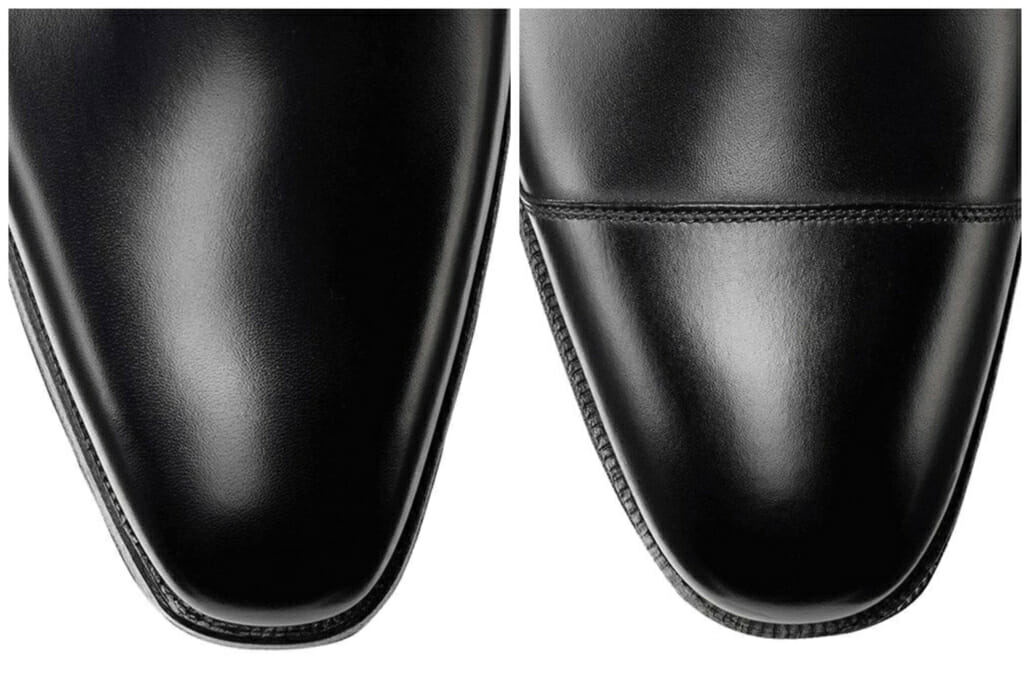
Crockett & Jones Last 348 (square toe) and 337 (called “a soft square”)One example is Crockett & Jones’ Last No. 348, which is worn by James Bond in the SPECTRE and Skyfall films and is the most widely used shape in their collection. The company calls this a square-toe, but no one would mistake it for the square toe shoe shown above.
We could call it a chiseled toe or straight toe instead, as there is no standard naming requirement across different brands. So use your judgment and trust your eyes when assessing a shoe labeled as having a square toe.
Pointed or Elongated Toes
Pointed shoes were once the rage in 15th-century Europe where they were called either crackows or poulaines.
These went to ridiculous extremes of length as a sign of virility (longer feet suggesting larger genitalia) and some even had bells at the tips.
They made a comeback in the winklepickers of the 1950s British rock scene and survive today in similar rock-n-roll boots (envision alligator skin) and in some cowboy boots. Thankfully, truly pointed shoes are hard to find in dress shoes that can be worn with classic menswear.
So, rather than speaking of pointed toes, when it comes to dress shoes, it’s more useful to speak of elongation. We already mentioned that almond-toe shoes as elongated, meaning the toe area of the shoe is extended. Shoes that are not elongated normally have a small amount of space beyond where your toes end, but elongated ones have more. 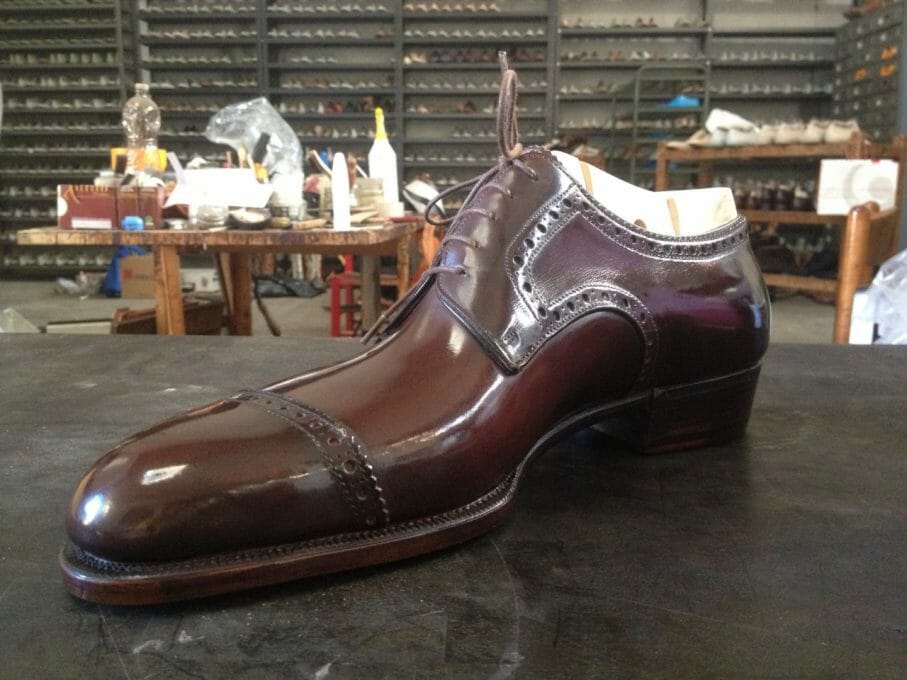
A highly elongated last (with a round toe): Riccardo Freccia Bestetti’s Boston shoeThis is especially true of toes that are chiseled or otherwise narrowed at the front; obviously, you can’t cram your toes into an area that is tapered, so the shoe has to be longer to accommodate the shape of the last.
A good example of this is Crockett & Jones’s 348 last, called the “Lowndes.” As they say, “The wearer may have at least an inch of space at the front of the toe box, which will not affect the heel to ball fitting as it is more for aesthetics.”
The elongation of the Lowndes is quite subtle, but, according to Donika at Crockett and Jones’ flagship shop on Jermyn Street, many men become alarmed when they put on one of their elongated models and look down at their feet. She recommends looking at elongated shoes in the mirror, rather than just by looking down at your feet in order to gauge whether the proportions are right.
If you have smaller feet or just like the style of a longer shoe, give it a try, but, as always, moderation is the key. You don’t want to look like you are wearing oversized clown shoes, but high-quality shoes from well-established brands won’t go to extremes, so you’ll be safe with them.
Shoe Toe Decorations
The All-Purpose Captoe
Besides its actual shape, the toe of a shoe also contributes to the overall appearance of footwear through its ornamentation or lack thereof. The simplest toe is completely unadorned, followed by the cap toe, in which the toe area of the shoe is separated off by a line of straight stitching, shown side by side in the Crockett & Jones 337 and 348 last images above. Since simplicity of design makes an article of menswear more formal, a plain or cap toe oxford is suitable for the requirements of morning dress and black tie, as well as for business suits.
Smart Casual Details: Wingtips and Broguing
Next up in terms of increasing ornamentation is the austerity brogue, which is the simplest form of wing-tip. This is made up of stitching in the shape of a W (technically, “a backward-extending point and curving sides”) to separate the toe from the rest of the shoe. The name originates from the austerity measures imposed on British shoemakers during World War II. Since they weren’t able to use the same amount of leather as required by a regular brogue, they simplified the design.
A spectator wingtip clearly shows the detailed design of the toe box in the usual wingtip, the wing shape is made up of a pattern of perforations that resembles lacework, but you can also find this as a straight band forming a captoe. This is the broguing, which was originally designed to allow water to drain out in country shoes worn in wet, muddy conditions.
The Formal Medallion
The last sort of broguing related to shoe toes is the medallion. This is an ornate geometric or floral pattern of perforations adorning the toe cap. You can find these alongside other brogue details, but they are sometimes the only bit of ornamentation on an otherwise fairly plain shoe. The latter will not be as formal as a plain cap toe, but a medallion can still feature on oxford shoes.
The Laid-Back Split Toe
Back to more casual shoes, there is one other type of toe feature that is worth mentioning, and that is the famous Norwegian split-toe, found on lace-up derbies and, occasionally, penny loafers. As the name says, there is a vertical seam right in the middle of the toe. Because of the visible heavy stitching, these shoes tend toward the casual, to be worn as any other derby.
Toe Color Variations
Finally, it’s worth mentioning that shoes can also feature a toe in a different color or material than the rest of the upper, such as cream suede on the vamp and brown calf leather at the toe. These are spectators, whether captoes or wingtips. But, for those who find spectators too showy and want a more subtle difference, many a brown dress shoe is available off the shelf with color variation in the patina, usually darker tones of brown, at the tip.
Conclusion
Like other style details–shirt collar shape, the rise on a pair of pants, or lapel width on a suit–the choice of toe shape should be governed by what looks best with your physical features. Just as a man with a round face should not wear a wide-spread shirt collar because it increases the impression of width, if you have smaller feet, you should probably avoid rounded toes and try an elongated last. The choice can balance your proportions.
It is also important to realize that these toe shapes also often appear in combinations, so you might have a shoe that is elongated with chiseled sides and a square toe, but once you know the varieties you should be able to identify them when you examine a pair of shoes. Then choose the shape and amount of ornamentation that suits your personality best.
from Gentleman's Gazette https://ift.tt/2OVav4Y
- Get link
- X
- Other Apps
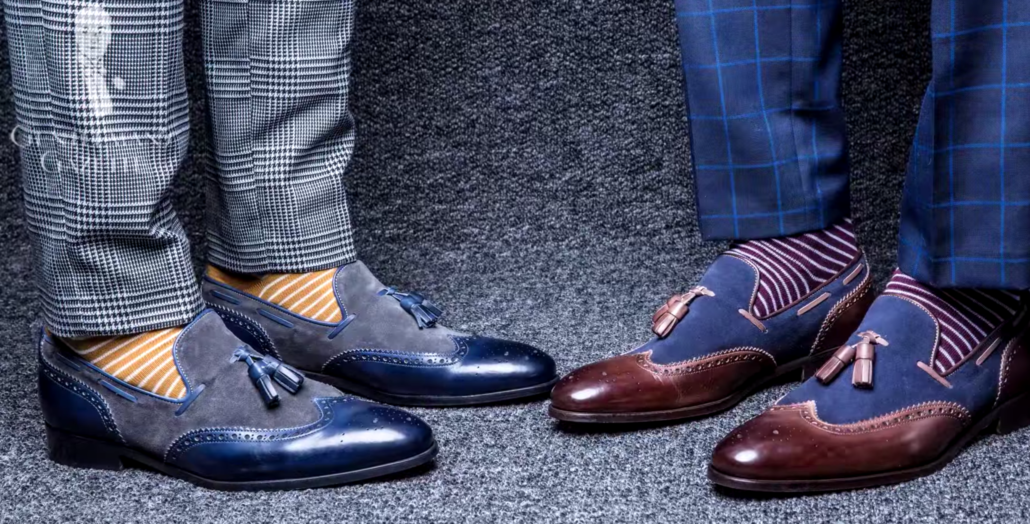
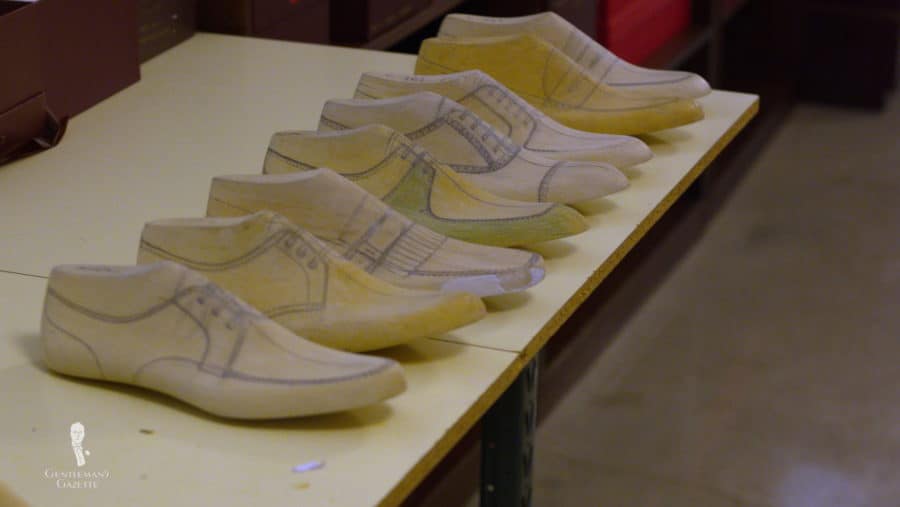
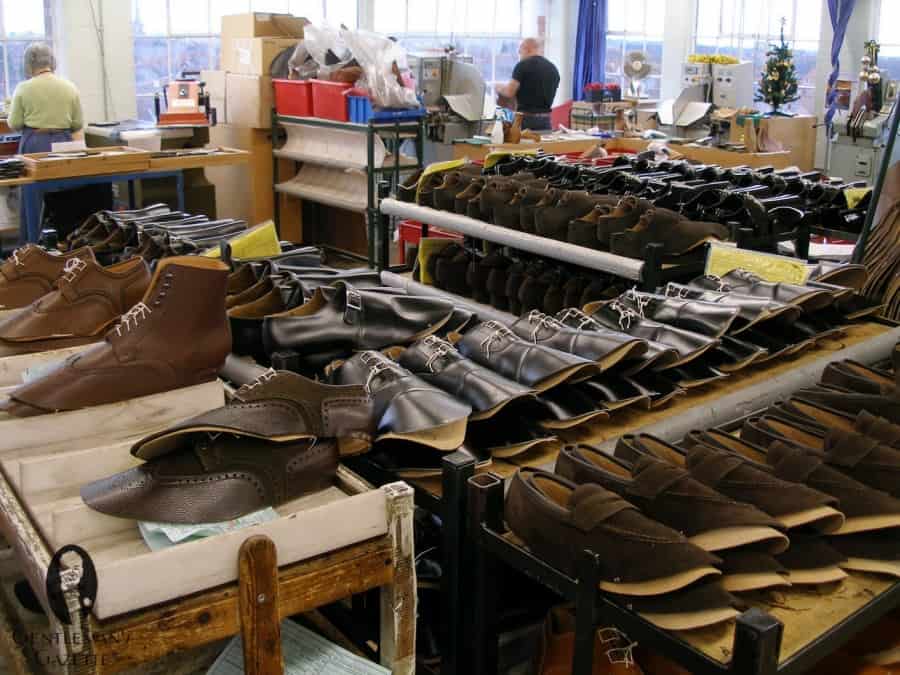
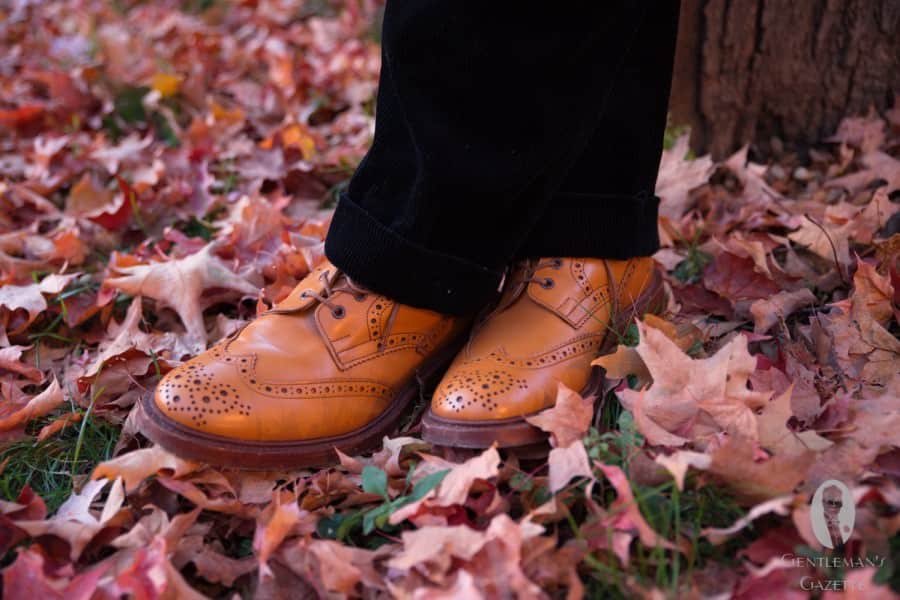
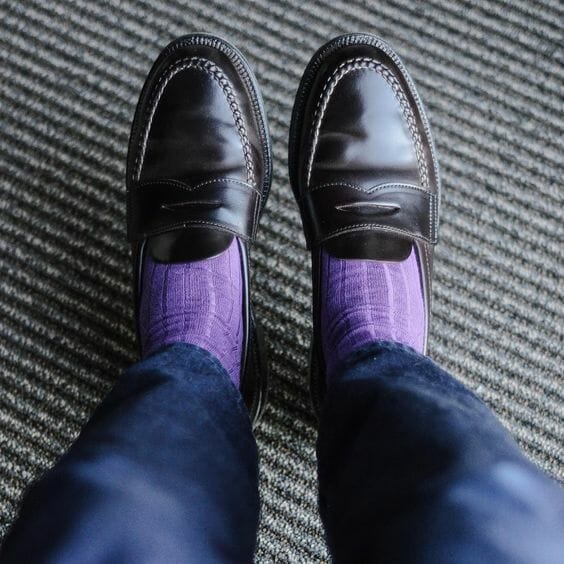
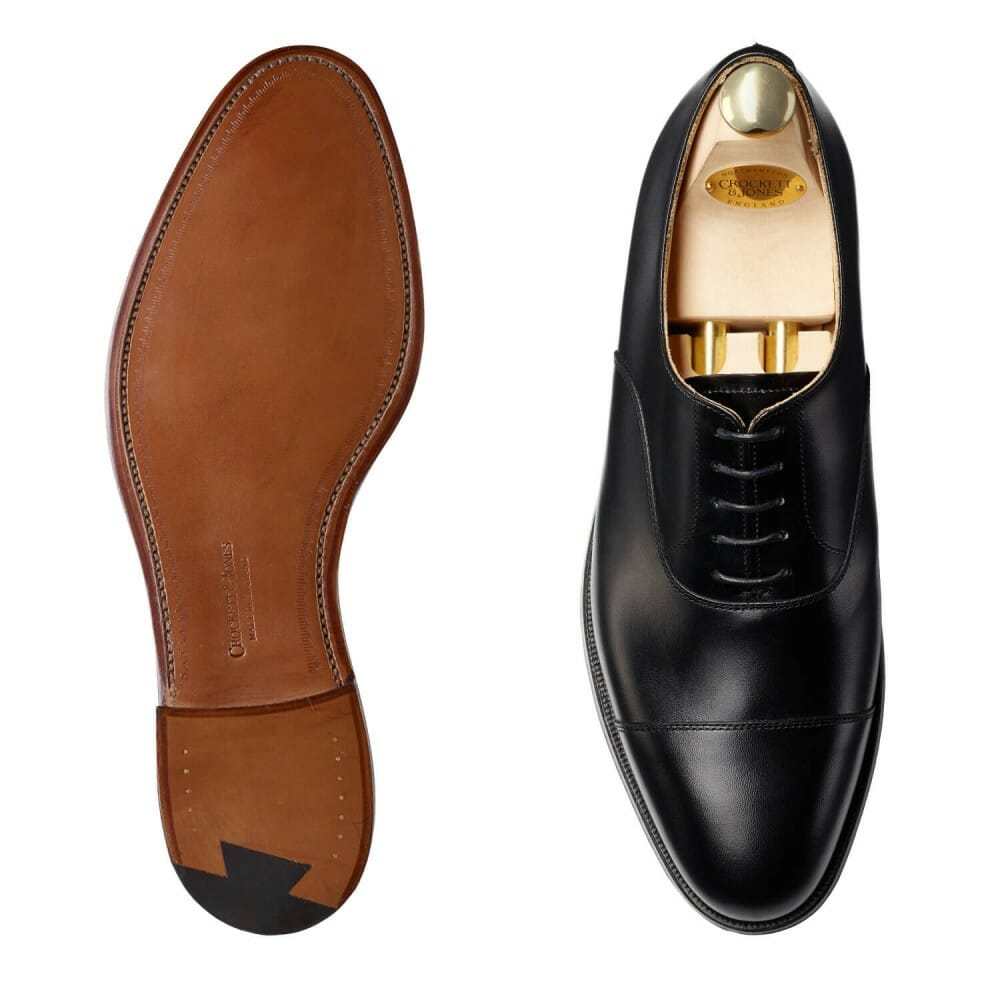
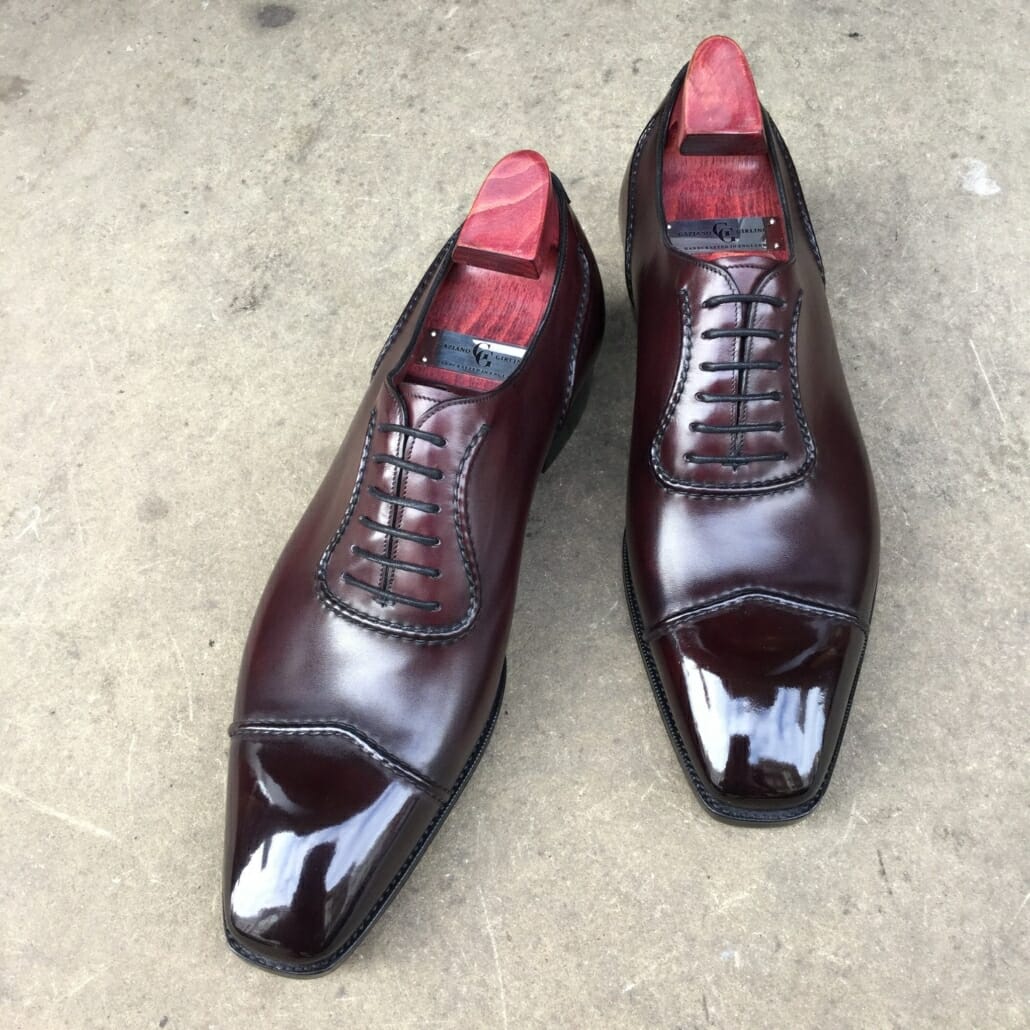

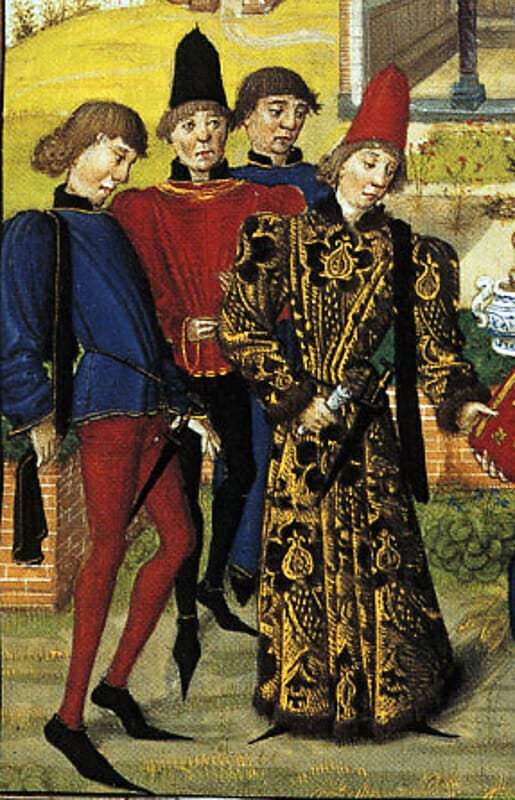
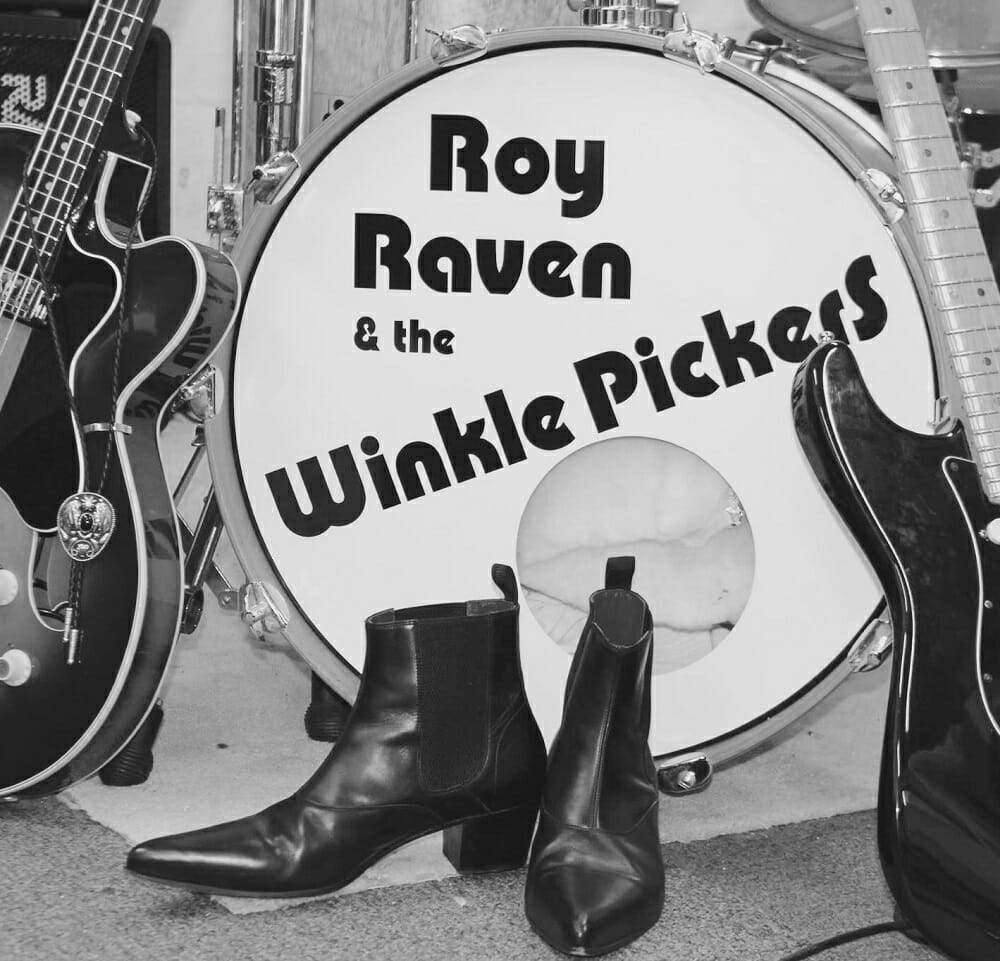
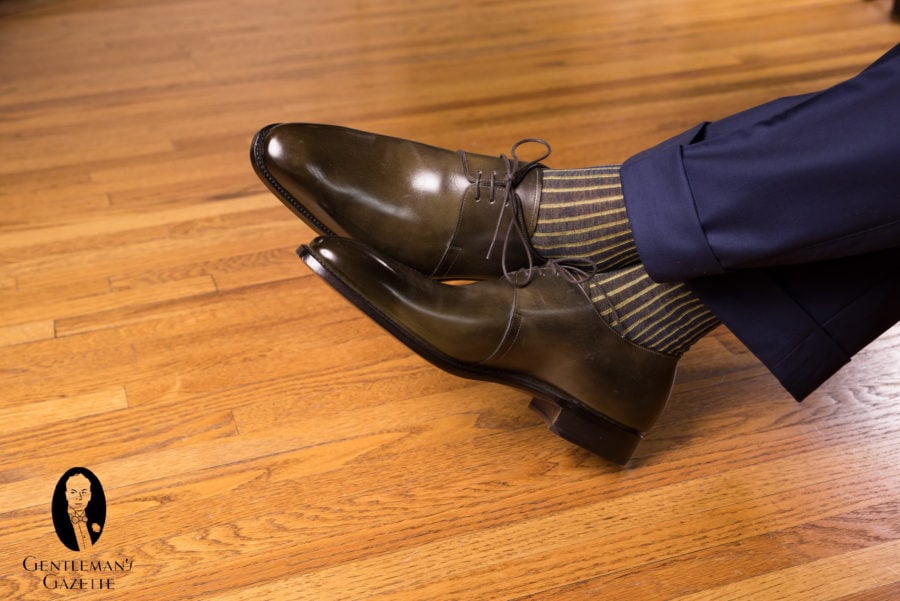
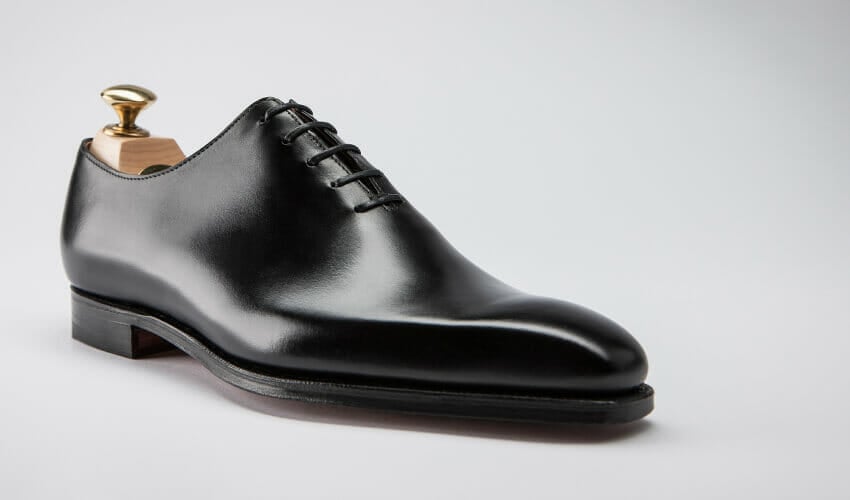
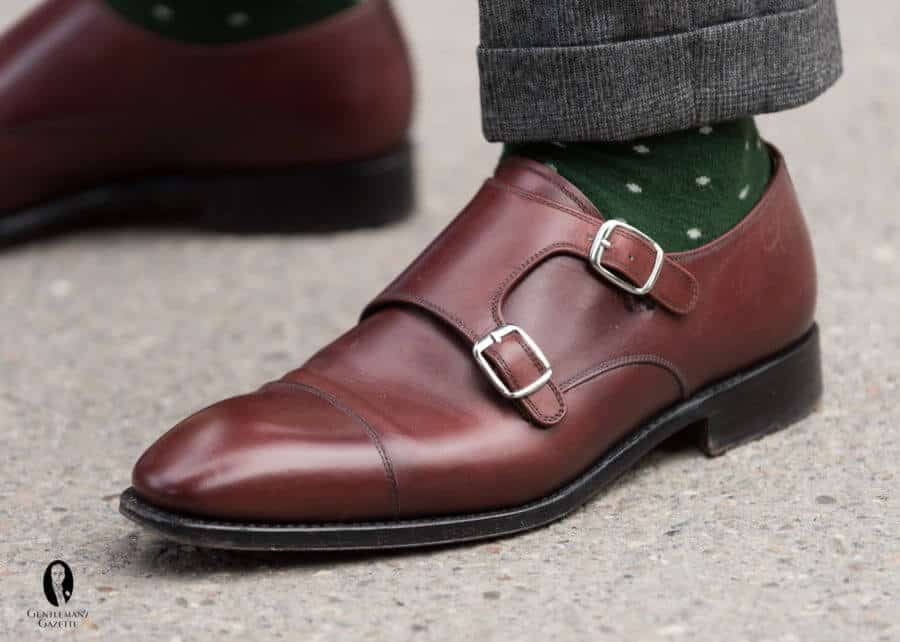
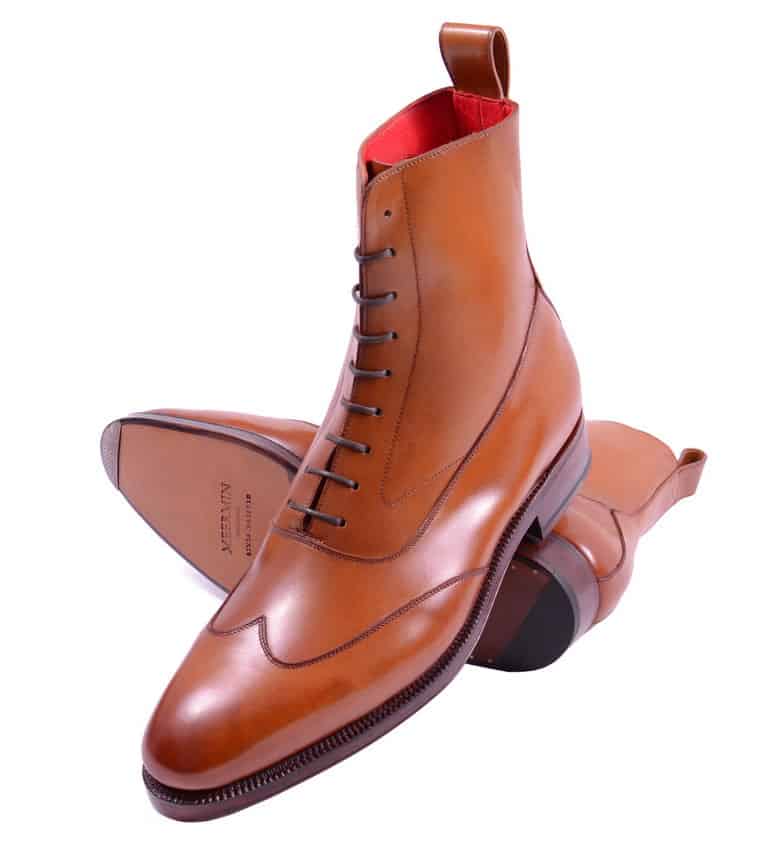
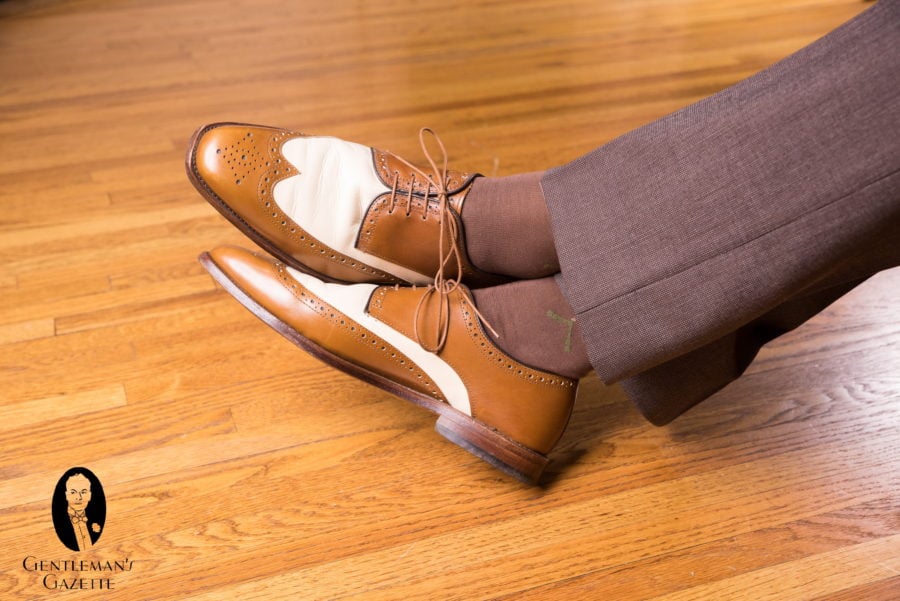
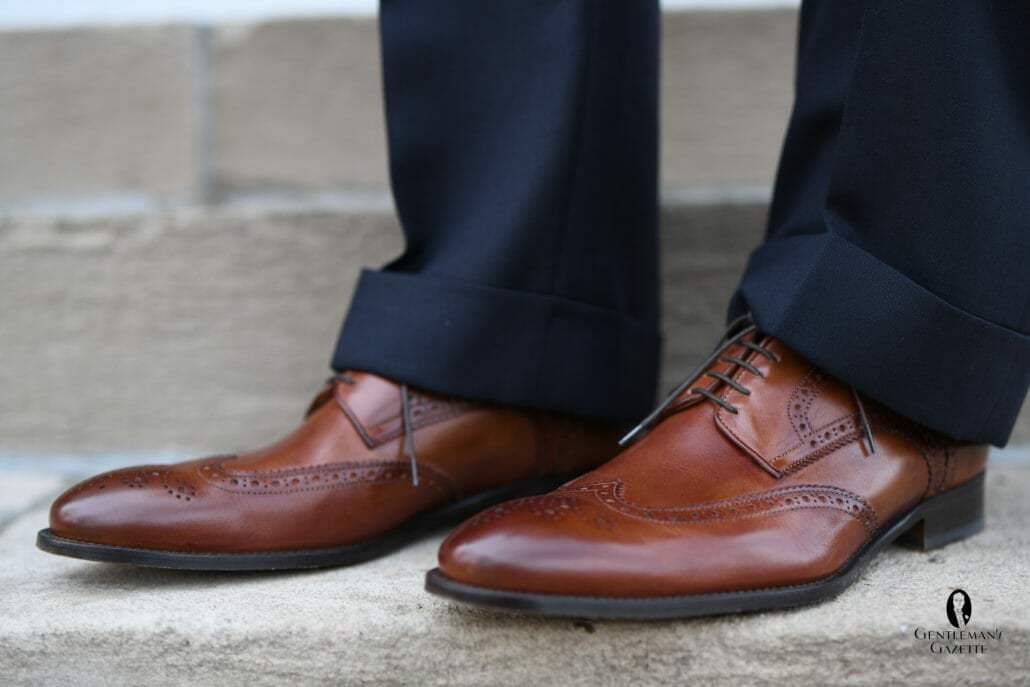
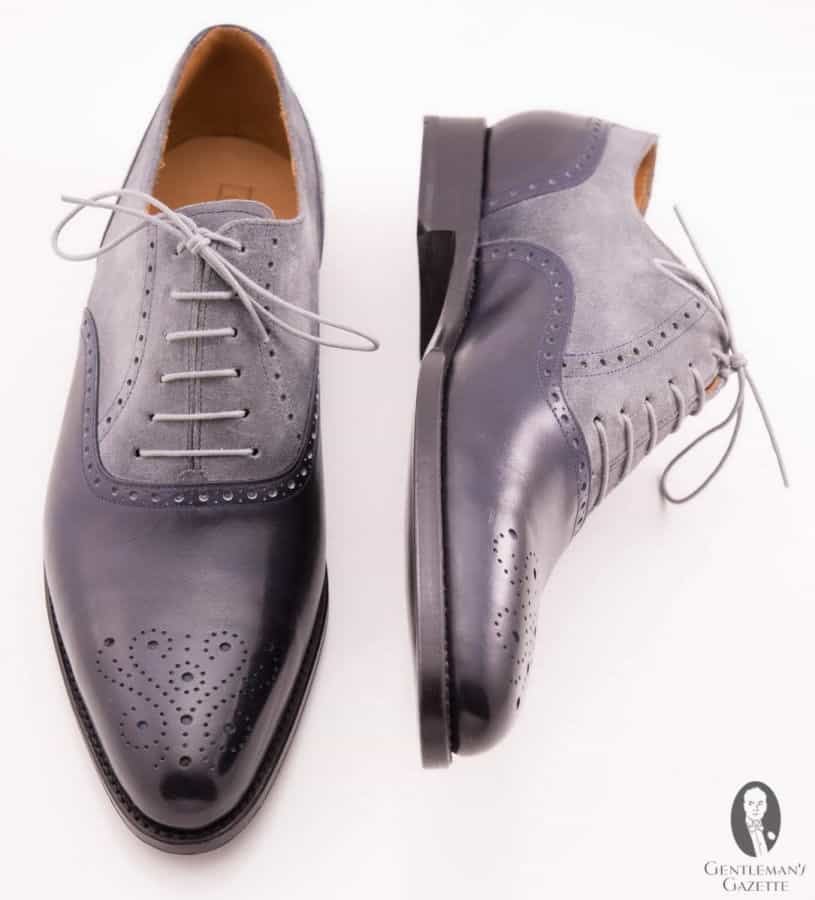
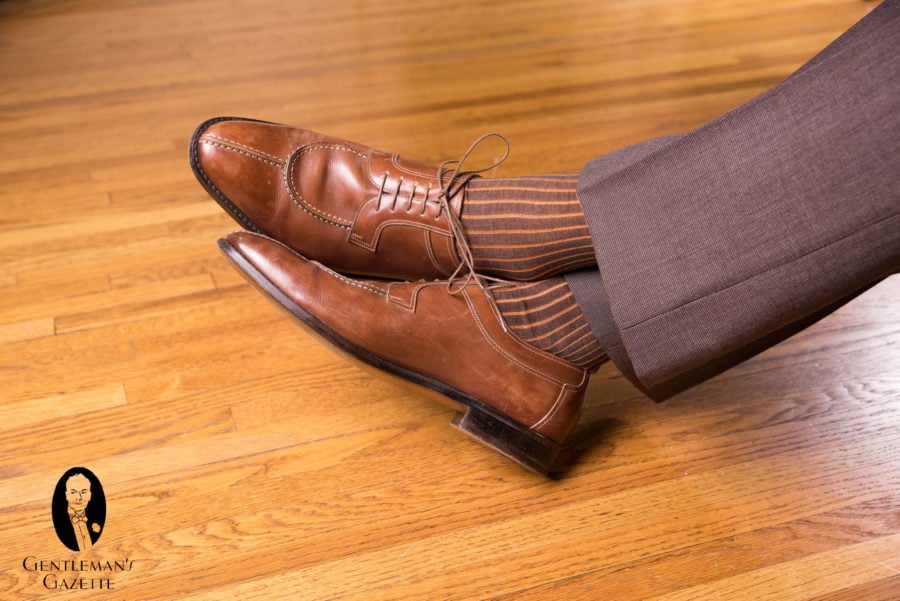
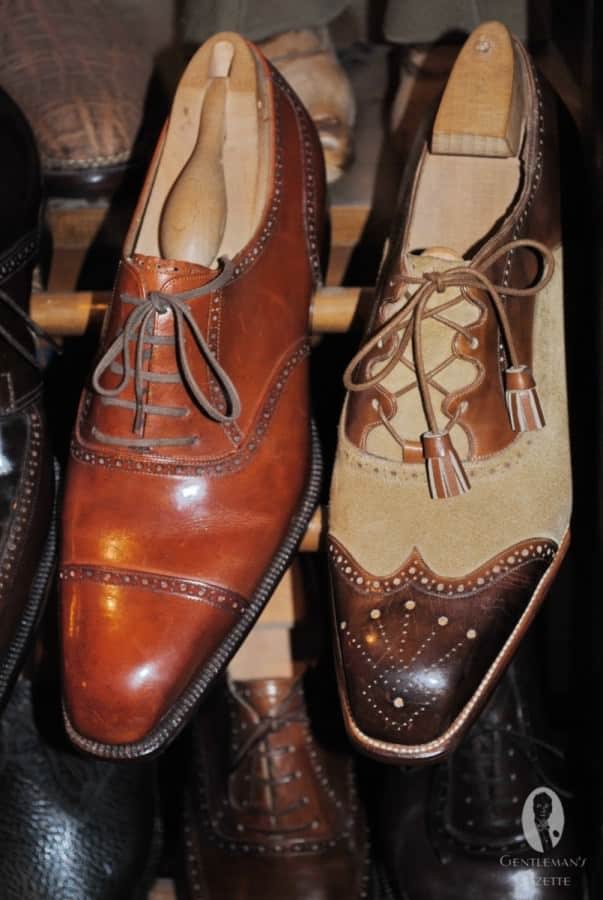
Comments
Post a Comment
thanks for your feedback